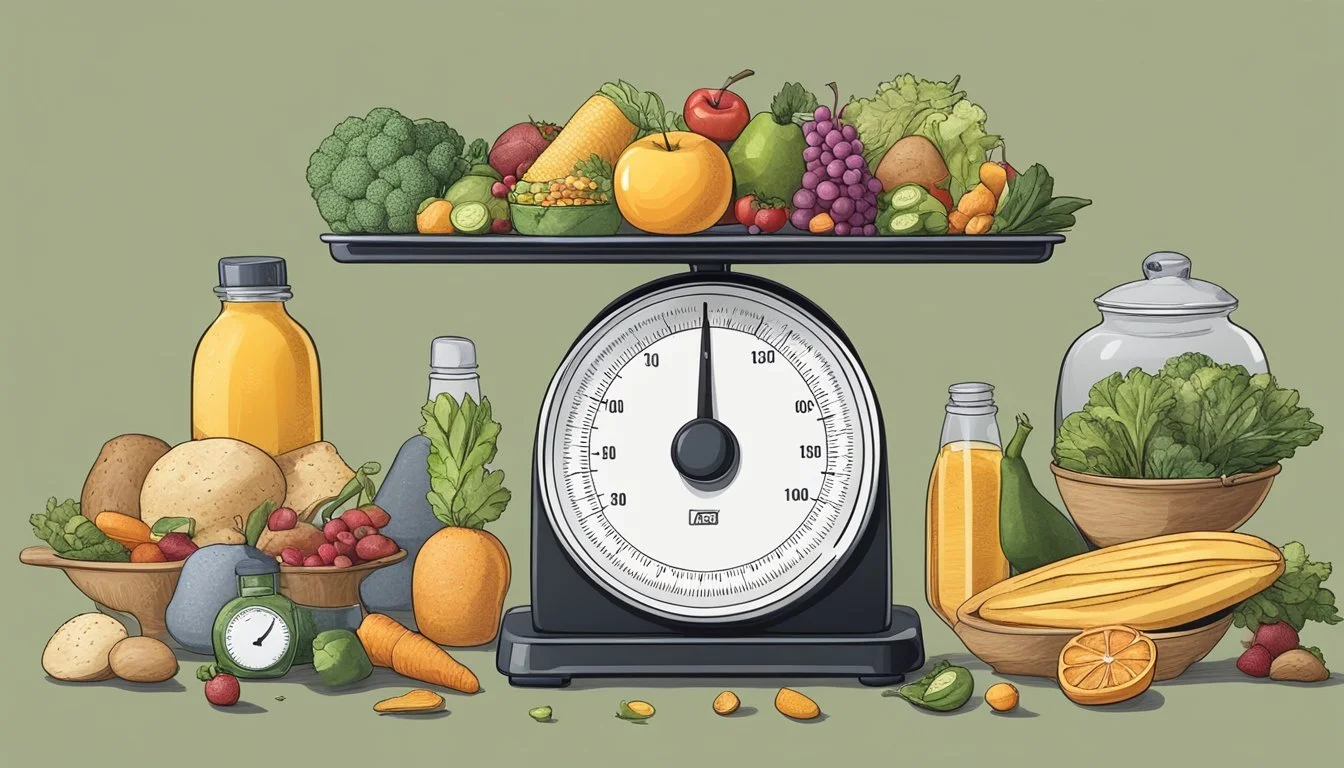The Myth of the "Calorie In, Calorie Out" Model
Examining the Oversimplification Debate
The "calorie in, calorie out" model is a traditional view of weight management, suggesting weight can be controlled by balancing the calories consumed with the calories expended through activity. At its core, it emphasizes a simple input-output mechanism, asserting that consuming more calories than one burns leads to weight gain, while consuming fewer results in weight loss. It's a model that has been widely taught and accepted as a cornerstone of nutritional advice.
However, an emerging body of research, along with anecdotal evidence, is challenging this model as an oversimplification. Critics argue that this model fails to account for the complexity of human metabolism, the nature of various caloric sources, and the role of hormones in weight regulation. They suggest that it does not fully explain why some individuals struggle to lose weight despite strict calorie counting, or why others maintain or lose weight effortlessly without tracking calories.
The Basics of Metabolism
Understanding metabolism is crucial for comprehending how the body uses energy and the relationship between calorie intake and weight management.
Energy Balance and Body Weight
Metabolism encompasses the processes that the body uses to convert food into energy for cellular functions. It's a combination of two processes: anabolism, the building of compounds, and catabolism, the breaking down of molecules. The body's energy balance is a delicate scale that tips according to the ratio of calories consumed to calories burned. Weight gain occurs when energy intake exceeds energy expenditure, whereas weight loss happens when energy expenditure outpaces intake.
Caloric Intake vs. Expenditure
Caloric intake refers to the calories a person gets from food and drinks, and it varies depending on dietary choices. Energy expenditure is the total amount of calories the body burns for basic bodily functions resting metabolic rate (RMR), physical activity (exercise and non-exercise activities), and the thermogenesis induced by digesting food. A thorough understanding of both factors is essential for evaluating the effectiveness of the 'calorie in, calorie out' model for weight management.
Critique of Calorie Counting
The 'calorie in, calorie out' model faces significant critique due to its lack of consideration for metabolic differences and the varying effects of different types of calories.
Biological Variation in Metabolism
Metabolic rates vary widely among individuals due to factors like genetics, age, muscle mass, and hormonal balance. This variation implies that two people consuming an identical number of calories might process and store those calories differently. Studies indicate that metabolic adaptation can alter energy expenditure in response to changes in diet or weight.
Quality of Calories vs. Quantity
Not all calories are created equal when it comes to their impact on health and weight. Proteins, fats, and carbohydrates are metabolized differently, affecting satiety, insulin response, and energy storage. For instance, 100 calories of vegetables are not equivalent to 100 calories of sugar in how they influence the body's hormonal response and subsequent calorie processing.
The Role of Hormones in Weight Regulation
Weight regulation is influenced by a complex interplay of hormones that affect appetite, metabolism, and fat storage. Rather than being a simple equation of calories consumed versus calories expended, these endocrine factors play pivotal roles.
Insulin's Impact on Weight
Insulin, a hormone produced by the pancreas, is vital for the regulation of blood glucose levels and has a direct role in weight management. It facilitates the uptake of glucose by the body’s cells for energy. When insulin levels are chronically high, typically due to a diet high in refined sugars and carbohydrates, the body's fat cells store more fat and limit the release of fat for energy. This process can lead to weight gain, especially when energy consumption through diet exceeds that which the body burns.
Insulin also influences other aspects of weight regulation, including:
Appetite control: High insulin levels can lead to decreased satiety.
Metabolic rate: Insulin can affect how the body burns calories at rest.
Other Hormonal Influences
Other hormones play significant roles in weight regulation, each contributing to the body’s energy balance equation.
Some key hormones include:
Leptin: Produced by fat cells to signal satiety and decrease appetite; however, leptin resistance can occur in obesity, blunting its weight-regulating effects.
Ghrelin: Often called the "hunger hormone," ghrelin triggers the feeling of hunger and stimulates appetite.
Cortisol: Known as the "stress hormone," cortisol can promote fat storage and increase appetite, particularly for high-calorie foods.
These hormones form a complex network that impacts body weight beyond caloric intake, encompassing elements like hunger signals, energy expenditure, and fat storage.
Physical Activity and Caloric Burn
Physical activity plays a crucial role in how the body burns calories, with varying impacts based on the type and intensity of the activity.
Exercise-Induced Energy Expenditure
When an individual engages in physical exercise, their body expends energy that goes beyond resting metabolic rate. This energy expenditure can be quantified in terms of calories burned and varies greatly depending on the exercise intensity, duration, and the person’s body weight. A high-intensity workout, such as interval training, will burn more calories in a shorter amount of time compared to moderate-intensity activities like walking.
Exercise Type Est. Calories Burned (per hour for a 150 lb individual) Running (6 mph) 680 calories Swimming (moderate) 423 calories Cycling (12-14 mph) 544 calories
Non-Exercise Activity Thermogenesis (NEAT)
NEAT is the caloric expenditure from activities that are not considered deliberate exercise, such as walking to the printer at the office or tapping a foot to music. These activities, although often minor and subconscious, contribute to the total daily caloric burn. NEAT varies substantially based on a person’s occupation, lifestyle habits, and even environmental factors.
Standing: On average, standing burns about twice as many calories compared to sitting.
Fidgeting: Can increase a person's metabolic rate by approximately 30%.
House chores: Activities like sweeping, dusting, or cooking can contribute to NEAT.
The disparity in NEAT among individuals highlights the complexity in calculating total daily energy expenditure and showcases why the "calorie in, calorie out" model may not capture the whole picture when it comes to weight management.
The Impact of Diet Composition
The dietary makeup influences energy balance and metabolic processes beyond simple calorie counting.
Macronutrients and Their Effects
Proteins: They have a higher thermic effect, increasing metabolic rate more than fats or carbohydrates.
Carbohydrates: Quality matters; complex carbs have different effects on blood sugar than simple sugars.
Fats: Essential for hormone production, but excessive intake of trans fats can be detrimental.
Processed Foods vs. Whole Foods
Fiber and Nutrient Density: Whole foods are generally higher in nutrients and fiber, which can affect satiety and caloric absorption.
Additives: Processed foods often contain additives that may interfere with hormonal and metabolic pathways related to weight gain.
Psychological and Behavioral Considerations
The "calorie in, calorie out" model does not sufficiently account for the psychological drivers of eating behavior, which significantly impact weight management.
Emotional Eating
Emotional eating is the act of consuming food in response to feelings rather than hunger. Studies indicate that emotions, such as stress, sadness, or boredom, can trigger eating habits that disregard caloric need. This behavior underscores the complexity of human eating patterns and the limitation of treating weight management strictly as a numbers game.
Sustainable Habits
Developing sustainable habits is central to long-term weight management success. Diet changes that are overly restrictive may lead to short-term weight loss but are likely to fail in the long run. Individuals are more likely to adhere to diets that integrate rather than disrupt their lifestyles, suggesting that flexibility and personalization are crucial for sustainable weight control.
External Factors Influencing Energy Balance
The concept of "calorie in, calorie out" fails to account for various external factors that can significantly alter an individual's energy balance. These factors can range from environmental conditions to socioeconomic status, each playing a distinct role in influencing metabolic processes and dietary choices.
Environmental Influences
Individuals living in different environmental settings experience varying levels of physical activity due to climate, geography, and infrastructure. For instance:
Climate: Extreme temperatures can suppress appetite or increase metabolic rate, altering energy needs.
Infrastructure: Accessibility to parks and recreational facilities promotes physical activity, impacting energy expenditure.
Socioeconomic Factors
A person’s economic status directly affects their food choices and, consequently, their energy intake. Key considerations include:
Income Level: Economic constraints can limit access to diverse and nutrient-dense foods, often leading to diets high in calorie-dense but nutrient-poor options.
Education: Awareness and knowledge about healthy eating practices influence dietary habits and thus calorie quality and quantity.
Case Studies and Research Evidence
Evaluating the "calorie in, calorie out" model necessitates a close inspection of empirical research and comparative diet studies, as well as an examination of longitudinal data that highlights the complex interplay of factors influencing weight loss and obesity.
Comparative Diet Studies
Research in the field often involves comparing different dietary approaches to understand how they affect weight loss beyond just calorie counting. Studies have shown that diets with the same caloric intake but different macronutrient compositions can lead to different weight loss outcomes. For instance, a low-carbohydrate diet may lead to more significant weight loss compared to a low-fat diet, even when caloric intake is matched across groups.
Study 1: A diet low in refined carbohydrates may improve the body's metabolism during weight loss, according to some case studies.
Study 2: In another study, participants consuming a diet higher in protein experienced greater satiety and retained more lean muscle mass.
Longitudinal Research Findings
Long-term research efforts paint a clearer picture of weight loss sustainability and the role that various factors play over time.
Study 1: Researchers have found that hormone levels, which can be altered by types of food intake rather than calorie count alone, play a role in long-term weight regulation.
Study 2: Data suggests that lifestyle factors such as sleep, stress, and exercise frequency contribute to an individual's ability to maintain a healthy weight.
These findings underline the importance of considering a multitude of elements that influence weight loss rather than solely focusing on the calorie content of the diet.
Future Directions in Weight Management Research
Advancements in the field of weight management research are moving beyond the traditional "calorie in, calorie out" model, seeking more nuanced understandings of metabolism and personalized nutrition.
Evolving Models of Metabolism
The scientific community recognizes that the metabolic process is complex and influenced by various factors beyond mere calorie counting. Research is now focusing on the hormonal response to food types, physiological differences between individuals, and how metabolism is influenced by genetics, microbiota, and even circadian rhythms. Future studies aim to elucidate the intricate networks controlling energy storage and expenditure, leading to more effective weight management strategies.
Personalized Nutrition Advancements
Nutrition science is heading towards a personalized approach, tailoring dietary recommendations to individual genetic profiles, lifestyles, and health status. Key developments include:
Nutrigenomics: The study of how food interacts with one's genes to affect individual health outcomes. This field will drive the creation of personalized dietary plans.
Advances in biomarker technology: This will provide real-time feedback on how a person's body responds to certain foods, enabling more precise nutrition recommendations.
Innovative technologies and interdisciplinary research are the pillars that will likely make the future of weight management more personalized and effective.







